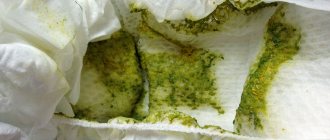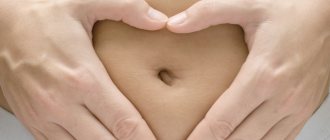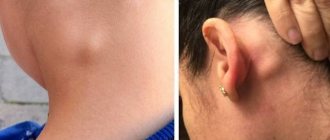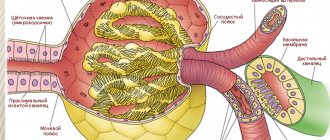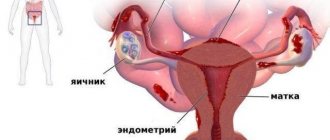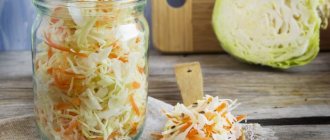What is it and should you worry?
Normally, an infant's stool is a pasty consistency of yellow and brown shades. When foam appears in it, this indicates that the fermentation process has begun in the intestines. Attentive parents immediately notice the child's foamy stool and begin to worry.
In fact, this phenomenon is not always a sign of pathology of the digestive system. When the child was in the womb, the digestive system in his body was just forming; he received the main nutrients from his mother. After the birth of the baby and the start of breastfeeding (BF), she just begins to work fully.
As digestive processes develop, which usually return to normal by 3 months of age, stool may change.
Stool characteristics may change over the first few years of life. If at the same time the newborn does not have deterioration in condition, pain, he feels normal and is cheerful, there is no reason for concern. But if other symptoms of digestive system diseases occur with foamy stools, you need to find out the reasons and consult a doctor.
Cause for concern also arises when foamy stool occurs at an older age. If at 1-2 months this may be normal, then at 3-4 years it is not. Problems with feces can also arise at about 1 year of age, if before that the child was breastfed, and now other foods are introduced into the diet.
Age norms
A breastfed newborn baby can have bowel movements as many times as he is fed. If a child has stool 1-2 times a day or less during the first 3 months of life, you should consult a doctor. For bottle-fed children under one year of age, constipation is considered to be the absence of independent bowel movements during the day.
A common cause of constipation in breastfed infants is disturbances in feeding and nutrient absorption. If there is quantitative underfeeding or good absorption of the mother's breast milk, the volume of feces in the child is not sufficient to arouse the urge to defecate. In such cases, retention of stool for 2–3 days is not considered true constipation. Constipation in infants who are breastfed and complementary foods is caused by a lack of foods containing plant fiber. Excess fat in food aggravates constipation, promoting the formation of soap in the intestines and thereby further hardening the stool.
In addition to reducing the frequency of bowel movements with constipation, children may experience a decrease in appetite and abdominal pain. With chronic constipation, the volume of stool increases.
Reasons related to maternal and child nutrition
If foamy stool is not normal, as evidenced by a deterioration in the child’s general condition and other signs, you need to pay attention to nutrition. Many reasons for such feces lie in the wrong choice of foods for feeding the baby and mother. In such cases, in order to normalize stool, it is enough to streamline your diet, avoiding junk food.
No ads 1
The main reasons related to the nutrition of mother and child are:
- Adding a new product to the diet. The stool may be either foamy or foamy and with mucus. You can try to remove the product and then introduce it into the diet after a while, but not earlier than after a month.
- Introducing complementary foods too early. Some mothers feel that the baby is not getting enough of her milk, and they immediately introduce additional foods into his diet. It is better to abstain from complementary foods until the age of six months, and if there is really little milk, then coordinate the choice of products with your doctor.
- Feeding errors. If a child constantly drinks only foremilk and does not get to the hindmilk, he misses out on many useful substances.
- With artificial nutrition. For a number of reasons, some mothers are unable to breastfeed their infants. Finding the right nutrition takes time. If the body does not accept the chosen product, it will give signals, one of which is foamy stool with a strong odor.
- Taking medications. Some medications taken by both mother and child contribute to the development of side effects that affect the digestive system. Loose stools with foam may be one of them.
- Errors in maternal nutrition. When breastfeeding, it is important for a woman to adhere to a diet and avoid prohibited foods. Violation of these rules can lead to problems with the formation of feces in the baby.
It is necessary to introduce new foods into the diet one at a time in order to understand which of them the body cannot yet process normally.
Foamy stool
Yesterday, out of the blue, we had such a problem (((
my daughter was feeding at the breast, and in the end, as usual, she began to walk with me, smile, flirt - that is, she was in a great mood... Then she strained herself - this also often happens with us, as the final stage of feeding)), she pooped with a bang... Then she continued to walk and smile... I took off the diaper and left her to poop... She pooped again and then came out with foam!!! Before that, I had only read or heard from friends that children can walk with foam... I couldn’t even imagine what it was... But it’s really like when you extinguish soda!! It's hissing! I was wildly scared! At the same time, we were not at home, visiting my mother... After several such sprays, it became clear that this was diarrhea... Liquid, with foam, but without much strain, and without changes in mood...
I measured the temperature - normal. I decided to give it some smecta. And upon arrival home, she also gave me enterofuril.
Today she farts with poop, but this has happened before. I pooped in a similar way today, once, also after feeding with the same mood...
What is this? what could it be from? I’ve already racked my brains for myself and those around me!
I didn't eat anything new. For lunch there was beef soup, although I baked a charlotte with apples for myself... But there was nothing dairy there, since I have a dairy-free diet. I ate baked and raw apples quite successfully...
Dysbacteriosis? Staphylococcus? Damn, now I can’t take the test again, since I started giving medications...
Before that, I had been giving primadophilus for a whole month, and this was the second day without the medicine...
As for the front milk, I don’t know... I have one “working” breast, by and large, it eats it all up... But lately there has been more milk - and I always start feeding with the “bad” breast, my daughter indulges in it, then freaks out and demands “good”, but in my opinion she doesn’t suck it out completely....Maybe because of this? but so abruptly...
Scary... what could it be? who had it? what did you do, how did you fight?
How I already want my tummy to normalize its work... I had such hope that by 3 months everything would be back to normal... apparently, it’s not fate... I’m already on a strict diet, I don’t know what to eat... I just wanted to expand my diet...
PS Just don’t advise me to finish breastfeeding and switch to formula. I really don’t want this, and I believe that, be that as it may, mother’s milk is the best thing that can be for a child.
By the way, we are gaining weight normally. In a month, about + 1 kg, probably half of it in the last few days... These two days are also an increase.
Other causative factors
Some causes of foamy stools are associated with serious pathologies and diseases of the digestive system. To understand that abnormalities in stool are not just an age-related norm, you need to pay attention to the accompanying symptoms.
The main causes are the following diseases:
- Intestinal dysfunction. This condition may be associated with several gastrointestinal diseases, such as dysbiosis, flatulence, and enzyme deficiency. Dysbacteriosis occurs most often in infants; it is associated with changes in microflora, which result in a deficiency of beneficial bacteria. Special treatment is usually not required; taking probiotics and adjusting your diet is enough.
- Intestinal infection. A dangerous condition that requires immediate medical attention. The infection can enter the intestines both with food and through infection from other organs. The main danger is associated with the risk of intestinal dehydration. Associated conditions are lethargy, weakness, nausea, vomiting, and stomach pain.
- Staphylococcus aureus. These bacteria are always present in the human body, but when their number increases due to various factors, problems arise. Due to its intense increase, immunity decreases, complications also affect the digestive system.
- Lactose intolerance or deficiency. Lactose is an important component of breast milk, which gives this product a lot of beneficial properties. Most of this substance is found in hind milk, and if the child does not receive enough of it, problems with feces arise.
The above causes of foamy stool can occur not only in newborns, but also in older children aged 4-5 years and older.
[node:field_field_doprekl]
Why do infants have foamy stools?
Foamy stools are very common in infants. If the baby looks healthy and active, and is gaining enough weight, then the issue may be due to improper breastfeeding. It is known that foremilk is watery and contains a lot of milk sugar - lactose. To digest it you need the enzyme lactase. The back is fatty and nutritious. There are not enough enzymes in the still immature digestive system to break down lactose with an excessive amount of foremilk received by the child. It is not absorbed by the body and is excreted in the feces, which is also diluted with water. This is how foam turns out.
It is not difficult to correct this situation. You just need to adjust your diet. Give your baby only one breast at each meal so that he empties it completely. If he doesn’t have enough and demands a second one, then start the next feeding with that one. You should not take the breast too early, even if it feels like the baby is sucking for too long.
Another reason that causes loose and foamy stools in infants is lactase deficiency. The body does not produce enough of the necessary enzymes, so mother's milk is not absorbed. In this case, the baby does not gain weight well. Sometimes this is due to dysbiosis, then with age or after taking probiotics the situation normalizes. But it happens, although very rarely, congenital lactase deficiency.
The presence of a problem is confirmed by an analysis of the amount of carbohydrates in the stool. Depending on the results, your doctor may prescribe enzymes to help digest the milk. Sometimes you have to switch your baby to a lactose-free formula.
In very young children, foamy stool often appears due to increased gas formation. As the gastrointestinal tract matures, feces become normal. This usually happens by 3-4 months, when colic goes away.
Diagnosis by stool color
By the way the stool looks, you can determine the possible cause of the deviation. Disturbances in the functioning of the gastrointestinal tract affect the process of fecal formation, so stool can change its color. Parents often find stools of these shades:
Baby's green stool
- Light. Most often it is a sign of dysbiosis, in which an excessive number of pathogenic bacteria are present in the intestines. And also light-colored foamy stools may be a sign that there is a bile deficiency. Poor outflow of this substance is a symptom of several diseases, so an ultrasound of all abdominal organs is required.
- Green. This type of stool is often called “hungry” - it is a sign that the child is not getting enough nutrients from food. If he has reached six months of age, this may be a sign of the need for complementary feeding. In other cases, dark green stool may be a symptom of an intestinal infection or staph.
- Yellow. Often this shade is normal, but over time it should fade to brown. If this does not happen or other problems appear, such as insufficient weight gain, abdominal pain, or deterioration in health, you should contact your pediatrician. Sometimes yellow, foamy stool indicates problems in the intestinal microflora.
- With red veins. Indicates lactose intolerance. Mom needs to reconsider her diet, reduce the amount of dairy products consumed. Less commonly, red streaks indicate intestinal dysfunction.
- White. It is rare and is a symptom of poor bile flow. In severe cases, foamy stools become white due to impurities of pus. Then urgent hospitalization and identification of the cause are required.
Photo
The photo below shows the main colors of stool, which are most common in young children and indicate problems in the gastrointestinal tract: yellow, green, with red streaks.
Yellow foamy stool.
Green foamy stool.
Foamy stool with red streaks.
[node:field_field_doprekl2]
What should parents do?
The actions of parents depend on the reason why the child has a problem. Even if he feels great, and there are no symptoms of deterioration, and you think that such feces are normal, it is better to consult a doctor. First, you need to go to a pediatrician; if necessary, he will give you a referral for an ultrasound of the abdominal organs or other diagnostics. If there are no deviations, the pediatrician can give recommendations on adjusting the diet for the mother and baby.
Attention! It is impossible to independently give your baby any medications aimed at normalizing the functioning of the gastrointestinal tract without an established cause for foamy stools.
If your baby has been diagnosed with dysbiosis, you will need to use drugs like Bifiform to restore the intestinal microflora. If lactose deficiency is detected, the mother needs to express her foremilk, feed her baby her hindmilk, and may also need to take certain medications.
One of the most serious diseases that can be detected with foamy stools is an intestinal infection. Urgent hospitalization is usually required, and therapy is prescribed to prevent dehydration and eliminate symptoms of infection.
Thus, foamy stool in infants may be normal, indicating that the digestive system is improving its functioning. Cause for concern arises when other symptoms of deterioration in the child’s condition appear or the problem does not go away with age. To determine the cause, you must contact your pediatrician, then follow his instructions regarding treatment.
Intestinal infections and other diseases, unhealthy diet
If a child’s diarrhea with foam is accompanied by other symptoms - high fever, vomiting, and there are also streaks of blood and mucus in the stool - then it is most likely an intestinal infection. It can be dangerous to the body and require urgent treatment to avoid serious consequences. Therefore, if you have foamy stools, you should carefully monitor the baby’s condition and consult a doctor in a timely manner.
Such stool may be a sign of worm infection. If they multiply in large numbers, they begin to negatively affect the digestive processes.
Advice
In case of loose, foamy stools, rice water may help. It should be given to the child 3-4 times a day.
Foamy stool also occurs with diseases of the gastrointestinal tract that provoke inflammation. To prevent them from becoming chronic, it is necessary to begin treatment in a timely manner. It can also mean celiac disease - gluten intolerance. When this protein enters the body, the intestinal mucosa becomes inflamed. To avoid this, you need to adhere to a strict diet, eliminating all gluten-containing foods.
Poor nutrition also causes problems with stool. If you give a 2-year-old child fatty foods, his body is unlikely to be able to digest it. You should not experiment with spicy and exotic dishes. So if foam is noticed in the stool, then it is necessary to reconsider the diet.
